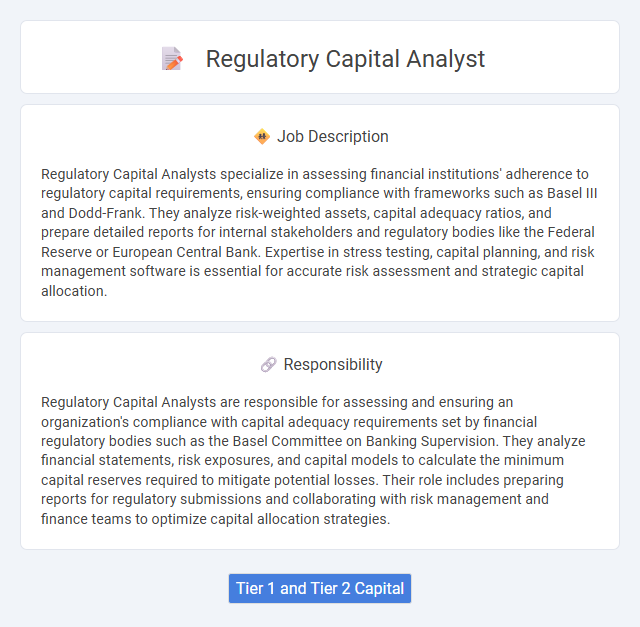
Regulatory Capital Analysts specialize in assessing financial institutions' adherence to regulatory capital requirements, ensuring compliance with frameworks such as Basel III and Dodd-Frank. They analyze risk-weighted assets, capital adequacy ratios, and prepare detailed reports for internal stakeholders and regulatory bodies like the Federal Reserve or European Central Bank. Expertise in stress testing, capital planning, and risk management software is essential for accurate risk assessment and strategic capital allocation.
Individuals with strong analytical skills and attention to detail are likely well-suited for a Regulatory Capital Analyst role. Those who thrive under pressure and can interpret complex financial regulations may find this position aligns with their strengths. Candidates who prefer dynamic environments and have a solid understanding of risk management principles probably have a higher probability of success in this job.
Qualification
A Regulatory Capital Analyst must possess a strong background in finance, accounting, or economics, often requiring a bachelor's degree or higher in these fields. Proficiency in regulatory frameworks such as Basel III, Dodd-Frank, and IFRS 9 is essential for accurate capital adequacy assessment. Advanced analytical skills, experience with financial modeling, and expertise in regulatory reporting tools like SAS, Excel, or Python enhance the ability to evaluate capital requirements effectively.
Responsibility
Regulatory Capital Analysts are responsible for assessing and ensuring an organization's compliance with capital adequacy requirements set by financial regulatory bodies such as the Basel Committee on Banking Supervision. They analyze financial statements, risk exposures, and capital models to calculate the minimum capital reserves required to mitigate potential losses. Their role includes preparing reports for regulatory submissions and collaborating with risk management and finance teams to optimize capital allocation strategies.
Benefit
Regulatory Capital Analyst roles likely offer significant benefits including enhanced expertise in financial regulations and risk management, which can improve career growth probability in the finance sector. This position may provide opportunities to work with data-driven decision-making, increasing job security in environments prioritizing compliance. Benefits such as competitive compensation and exposure to dynamic regulatory environments could also contribute to long-term professional development.
Challenge
Regulatory Capital Analyst roles likely require navigating complex financial regulations and interpreting evolving compliance standards, presenting a continuous challenge to maintain accurate capital adequacy assessments. The position probably demands strong analytical skills to forecast regulatory impacts and adjust strategies accordingly under uncertainty. Managing data integrity and aligning with regulatory frameworks may often test the candidate's problem-solving abilities and attention to detail.
Career Advancement
Regulatory Capital Analysts play a critical role in ensuring that financial institutions comply with capital adequacy requirements set by regulatory bodies such as Basel III and Dodd-Frank. Expertise in risk assessment, capital modeling, and regulatory reporting opens pathways to senior roles like Risk Manager or Chief Financial Officer. Continuous skill development in financial regulations and advanced analytics significantly enhances career advancement opportunities within banking and financial services sectors.
Key Terms
Tier 1 and Tier 2 Capital
Regulatory Capital Analysts specialize in assessing and managing financial institutions' compliance with capital adequacy requirements, focusing on Tier 1 and Tier 2 Capital components outlined in Basel III standards. They analyze Tier 1 Capital, which includes common equity and disclosed reserves, to ensure the institution maintains a strong core capital buffer against risks, while Tier 2 Capital involves supplementary elements such as subordinated debt and loan loss reserves that provide additional financial resilience. Expertise in regulatory reporting, risk-weighted assets calculations, and capital optimization strategies is critical for maintaining regulatory compliance and supporting organizational financial stability.
 kuljobs.com
kuljobs.com